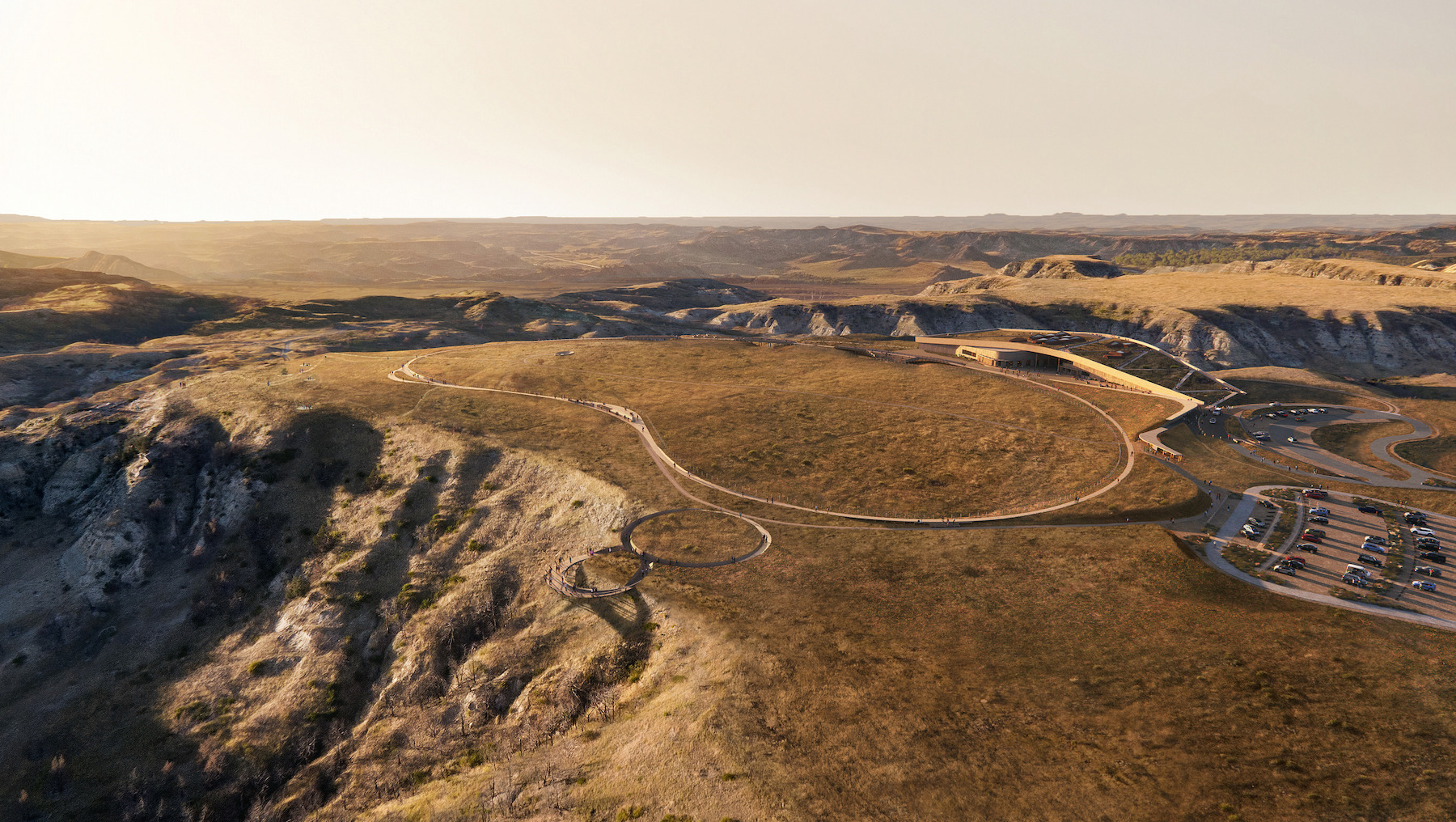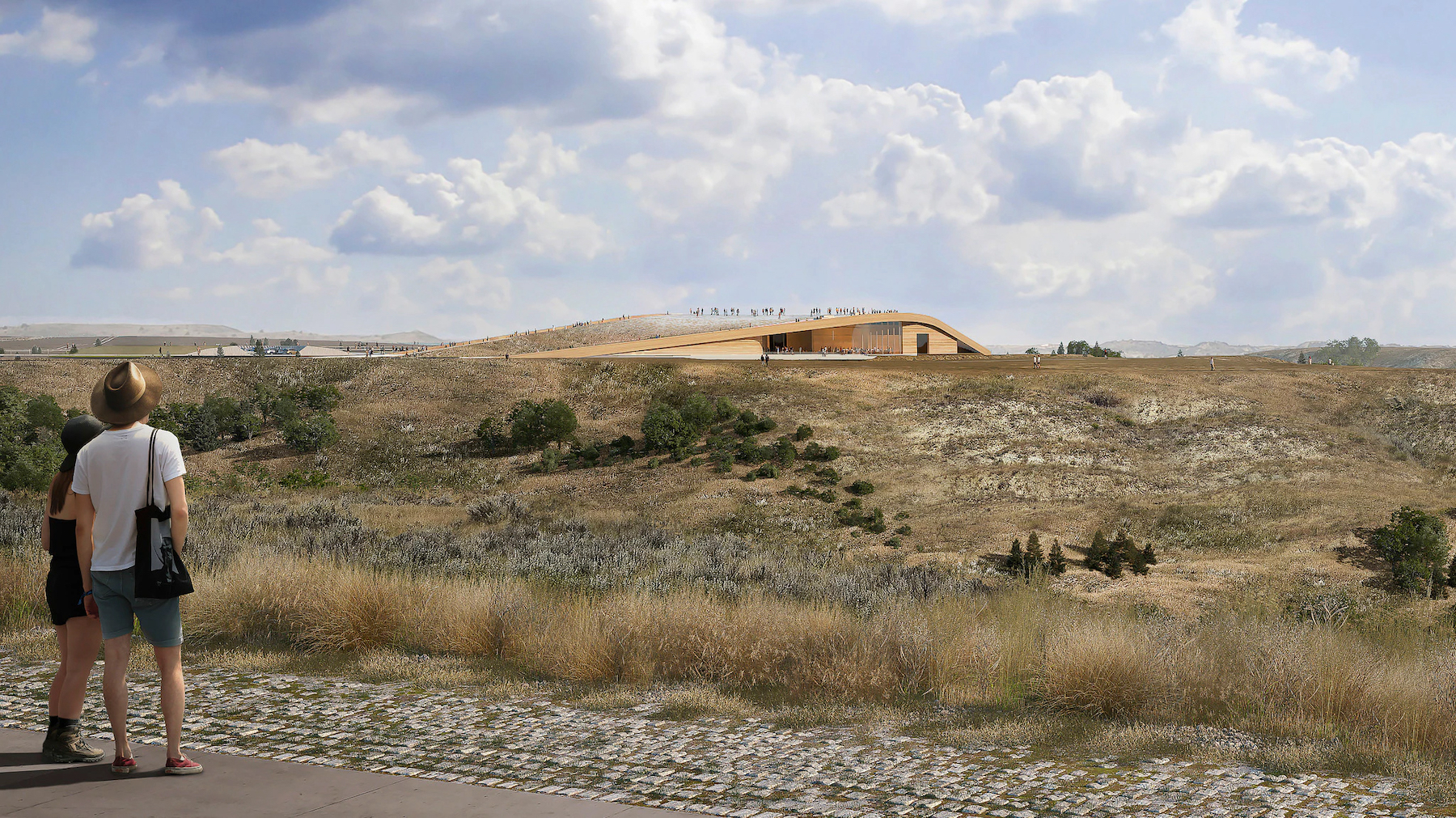On July 4, 2026, the Theodore Roosevelt Presidential Library is scheduled to open on 93 acres in Medora, a town in North Dakota with under 130 permanent residents, but which nonetheless has become synonymous with the 26th President of the United States, who lived there for several years in the 1880s.
The under-construction $333 million library, situated on a Badlands butte near the Burning Hills Amphitheater, will not be a repository for Roosevelt’s papers or archives (which are mostly housed at Harvard University). Instead, the library’s goal is to honor the President’s legacy as a conservationist. Its design is informed by Roosevelt’s interest in environmental stewardship and his reflections about the landscape.
The single-story, 93,000-sf library/museum “is a journey preserving the existing landscape of diverse habitats punctuated with small pavilions allowing for reflection and activity,” according to the project’s website. “The main building’s gently sloping roof looks to the northeast, gazing out to the [70,447-acre] National Park, historical settings in the Little Missouri River valley, and the Elkhorn Ranch far in the distance, further connecting the Library of tomorrow with its origins of the past.”
“The Library is the landscape,” Edward O’Keefe, CEO of the Theodore Roosevelt Presidential Library, told the New York Times.
Mass timber complements construction

Mass timber is a significant component in the construction of the Library. The Mercer Mass Timber subsidiary of Mercer International is providing nearly 1,800 cubic meters of cross-laminated timber and glulam––harvested from sustainably managed forests––which are being used for the building’s structure that includes a green walkable roof, as well as a one-mile-long boardwalk loop in front of the Library that aligns with the roof’s curvature.
The green roof aims to restore the vegetation disrupted within the building’s footprint, and to create a habitat for native plants. The Library is sponsoring this Native Plant Project in partnership with Resource Environmental Solutions, the nation’s largest ecological restoration company; and North Dakota State University.
Within the Library there will be “narrative galleries,” as well as community spaces, a café, and an auditorium, which the Times pointed out would be large enough to host candidate debates during presidential election campaigns.
The Library “represents a transition we’re seeing in modern library and architectural design, where community spaces are being constructed with long-term sustainability in mind,” said Nick Milestone, Mercer’s Vice President of Projects and Construction, in a prepared statement.
In partnership with the project’s general contractor JE Dunn Construction, Mercer is providing mass timber design assistance, materials, and coordination and logistics. Other AEC firms involved in this project: Snøhetta (design and landscape architect), JLG Architects (AOR), Seagate (mass timber installation), Magnusson Klemencic Associates (Engineer of Record), and Command Industires (steel subcontractor).
The Library––which is four and a half hours north of Mount Rushmore and seven hours northeast of Yellowstone National Park––is targeting LEED Platinum and Living Building Challenge certifications. Its goal is to be net-zero energy, emissions, water, and waste.
Related Stories
| Jun 9, 2014
Green Building Initiative launches Green Globes for Sustainable Interiors program
The new program focuses exclusively on the sustainable design and construction of interior spaces in nonresidential buildings and can be pursued by both building owners and individual lessees of commercial spaces.
| May 29, 2014
7 cost-effective ways to make U.S. infrastructure more resilient
Moving critical elements to higher ground and designing for longer lifespans are just some of the ways cities and governments can make infrastructure more resilient to natural disasters and climate change, writes Richard Cavallaro, President of Skanska USA Civil.
| May 23, 2014
Top interior design trends: Gensler, HOK, FXFOWLE, Mancini Duffy weigh in
Tech-friendly furniture, “live walls,” sit-stand desks, and circadian lighting are among the emerging trends identified by leading interior designers.
| May 20, 2014
Kinetic Architecture: New book explores innovations in active façades
The book, co-authored by Arup's Russell Fortmeyer, illustrates the various ways architects, consultants, and engineers approach energy and comfort by manipulating air, water, and light through the layers of passive and active building envelope systems.
| May 19, 2014
What can architects learn from nature’s 3.8 billion years of experience?
In a new report, HOK and Biomimicry 3.8 partnered to study how lessons from the temperate broadleaf forest biome, which houses many of the world’s largest population centers, can inform the design of the built environment.
| May 13, 2014
19 industry groups team to promote resilient planning and building materials
The industry associations, with more than 700,000 members generating almost $1 trillion in GDP, have issued a joint statement on resilience, pushing design and building solutions for disaster mitigation.
| May 11, 2014
Final call for entries: 2014 Giants 300 survey
BD+C's 2014 Giants 300 survey forms are due Wednesday, May 21. Survey results will be published in our July 2014 issue. The annual Giants 300 Report ranks the top AEC firms in commercial construction, by revenue.
| May 10, 2014
How your firm can gain an edge on university projects
Top administrators from five major universities describe how they are optimizing value on capital expenditures, financing, and design trends—and how their AEC partners can better serve them and other academic clients.
| May 9, 2014
New York Public Library scraps drastic renovation plans
The New York Public Library's controversial renovation, involving the removal of stacks from the Schwarzman building and the closing of the mid-Manhattan branch, has been dropped in favor of a less dramatic plan.
| Apr 29, 2014
USGBC launches real-time green building data dashboard
The online data visualization resource highlights green building data for each state and Washington, D.C.















